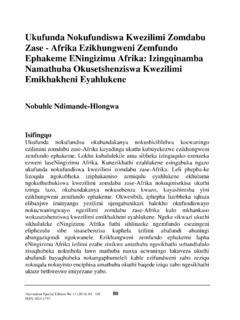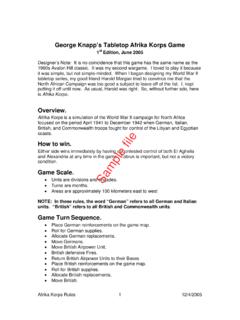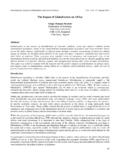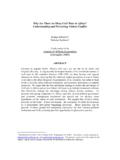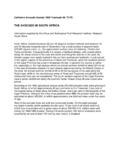Transcription of AFRIKA KORPS; Wargame Academy Amplified Third Edition ...
1 AFRIKA KORPS; Wargame Academy Amplified Third Edition Rulebook Page 1 of 13 THE AVALON HILL GAME COMPANYS TRADEMARK FOR ITS DESERT CAMPAIGN GAME 1. COMPONENTS: THE MAPBOARD: The map board shows the area where the western desert campaign was actually fought. It covers approximately 700 miles between El Agheila and El Alamein. Map spellings are according to British War Office maps. A hexagonal grid has been superimposed on the mapboard to determine movement. Important features include: GRID COORDINATES: Black numbers printed along the south and east edges of the board are used to identify individual hexes.
2 The letters are read horizontally (east-west), the numbers diagonally from southwest to northeast. When a number and letter are cross-indexed they pinpoint a certain location on the map. Examples: Agheila is W6, El Alamein is L59, ESCARPMENT: Any hex containing brown splash contours (Example: G24 ): NOTE: Hex T29 is not a pass through the escarpment: QATTARA DEPRESSION: Any hex containing brown dots wholly OF partially within the brown lines of the area labeled QATTARA DEPRESSION. (Example: R60). FORTRESS: Bengasi (H2), Tobruk (G25). Alternate spellings: Benghazi, Tobruch. COASTROAD: Any hex containing a red line (Example: K61).
3 GERMAN HOME BASE: Gray hex at W3, ALLIED HOME BASE: Gray hex at J62. UNIT COUNTERS: The die-cut, Order of Battle Unit Counters are the tokens whose movement and placement determine the course of play. The Blue pieces are Allied; Red are Axis (a term referring to the German-Italian alliance). Hereafter they will be referred to simply as units. Printed on each unit is information necessary for play of the game. There are five different unit sizes: Counter Symbol Unit Size XXX Army Group XX Division X Brigade III Regiment II Battalion The nationality of pieces can be determined as follows: Counter Nomenclature Description A Australian NZ New Zealand I Indian SA South African It Italian Unmarked Red German Unmarked Blue British The types of pieces are determined as follows: Identification is provided only for historical reference.
4 It is not necessary for play of the game, and players not wishing to take the time to set up the game with the correct historical units can ignore this information and bring units into play solely on the basis of their combat and movement factors (see ) The attack factor is the basic strength of the unit when attacking. The defense factor is the basic strength of the unit when defending. The movement factor is the maximum number of clear terrain hexes a unit may move into in one turn. RULEBOOK: The rulebook contains all rules, charts and tables necessary for play of the game. DIE: The six-sided die is used only to resolve combat and the arrival of Axis supplies; it has nothing to do with movement.
5 TIME RECORD CARD: The Time Record Card is used to record the passage of turns and indicates the availability of reinforcements, replacements, and Allied substitute counters, as well as possible changes in Axis supply arrival status, and the approaching end of the game. AFK; Revised and reformatted by Wargame Academy for internal use only AFRIKA KORPS; Wargame Academy Amplified Third Edition Rulebook Page 2 of 13 2. PREPARE FOR PLAY Lay the mapboard out on a long table. The Axis player sits at the northern side; the Allied player at the southern side. Punch out the unit counters from their die-cut sheet and place the corresponding units on the Order of Appearance tables printed on the mapboard.
6 These units are the Reinforcements ( ) which both sides receive at various intervals throughout the game. Place the units shown on the March 1941 Situation Chart on their respective listed positions on the mapboard. Stacking limits ( ) can be ignored during this preliminary setup but must be adhered to at the conclusion of each player s movement and also at the end of each player s turn. Place the remaining four Axis and five Allied supply counters off the board in an accessible place where they can be brought into play as dictated by the course of the game. The remaining counters are Allied substitute counters (21) which cannot enter play until August, 1942.
7 Put them aside for later use. The blank red and blue counters are merely spares to replace potentially lost units. You are now ready to begin play. MARCH 1941 SITUATION CHART 3. SEQUENCE OF PLAY AFRIKA KORPS is played in turns. The Axis player moves all of his units which he cares to move, and resolves any resulting battles. That is his player turn. The Allied player moves all of his units which he cares to move, and resolves any resulting battles. That is his player turn. Together these two player turns comprise a complete game turn and are measured as the passage of half a month of real time. The exact sequence of play is outlined below.
8 If the Axis player controls a port ( ) at which he can bring in supply, and provided there are less than three Axis supply units (not including captured supply units) already on the board and in play), he rolls the die and consults the Supply Table ( ) to determine whether he receives a supply unit that turn. If successful, he places it at the controlled port of his choice. He then consults the Time Record Card. If he is due additional units to enter play that turn he places them on board at a controlled port of his choice. The Axis player then moves all of his units on board (including just arrived supply, reinforcement, and replacement units) which he chooses to move.
9 No Allied movement is allowed. All attacks caused by Axis movement are resolved one attack at a time in the order the Axis player wishes them to be resolved, subject to any other rules contained herein. After each attack, the Axis player decides whether or not to execute movement after combat if applicable. Provided the Allied Player has less than four Allied (not counting captured supply units) supply units in the game already, the Allied player brings on a supply unit at any controlled port providing he is entitled to and wants it. After consulting the Time Record Card he places any additional units he is due on board in a controlled port of his choice.
10 He then moves all his units on board which he chooses to move. No Axis movement is allowed. All attacks caused by Allied movement are resolved one attack at a time in the order the Allied player wishes them to be resolved, subject to any other rules contained herein. After each attack, the Allied player decides whether or not to execute movement after combat if applicable. The Allied player checks off one game turn on the Time Record Card and players repeat Steps through for the duration of the game. 4. VICTORY CONDITIONS The Axis player wins if he has eliminated all Allied combat (not supply) units currently on the board, or controls both fortresses and both home bases simultaneously for two consecutive Axis player turns (at the beginning and end of each turn) by his last October, 1942 turn.

